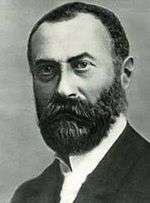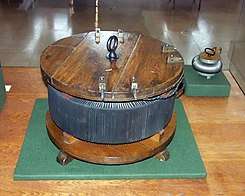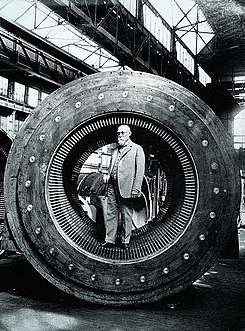Ottó Bláthy
Ottó Titusz Bláthy (11 August 1860 – 26 September 1939) was a Hungarian electrical engineer. In his career, he became the co-inventor of the modern electric transformer,[1][2] the tension regulator,[3] the AC watt-hour meter.[3][4]motor capacitor for the single-phase (AC) electric motor, the turbo generator,[5] and the high-efficiency turbo generator.
Ottó Bláthy | |
|---|---|
 | |
| Born | 11 August 1860 |
| Died | 26 September 1939 (aged 79) Budapest, Hungary |
| Nationality | Hungarian |
| Known for | Electric transformer, parallel AC connection, and AC electricity meter |
| Scientific career | |
| Fields | Electrical engineering |



Bláthy's career as an inventor began during his time at the Ganz Works in 1883. There, he conducted experiments for creating a transformer. The name "transformer" was created by Bláthy. In 1885 the ZBD model alternating-current transformer was invented by three Hungarian engineers: Ottó Bláthy, Miksa Déri and Károly Zipernowsky. (ZBD comes from the initials of their names). In the autumn of 1889 he patented the AC watt-meter.[6]
Early life
He attended schools in Tata and Vienna, where he obtained diploma of machinery in 1882. Between 1881 and 1883 he worked at the machinery workshop of the Hungarian Railways (MAV). Attracted by the successes of Károly Zipernowsky, he joined his team on 1 July 1883. He admitted he had learnt nothing about electrotechnics in university, so he started to learn about the theory himself. Using the Maxwell equations he invented a practical approach of sizing magnetic coils. Kapp and Hopkinson (for whom Hopkinson's law is named) only published their findings later in 1886 and 1887, respectively.
Professional life
His practical calculation method was crucial in building the first practical transformer. Based on his findings, he rebuilt his machines in 1883 and obtained better efficiency with the same weight. He was the first to investigate the heat dissipation problems of electric motors, and at that time the connection between current density and heat was determined.
At the Turin Italian National Exhibition in 1884, he saw Gaulard and Gibbs's "secondary generator"' (i.e. AC transformer) system, and he decided to improve it. Including a closed-loop magnetic field, based on the findings of Faraday, he conducted experiments with Miksa Déri in the summer of 1884 at the Ganz factory. Based on these experiments, they invented the transformer in 1885, which was unveiled at the Budapest National Exhibition in 1885.
Based on the opinions of Galileo Ferraris, the Italian government ordered a power transformer for Rome, which was installed in October 1886. Later, they designed a power plant for Tivoli, built by Ganz, with six water turbines and 5000 V, which were worked in parallel with the old steam engine generators. This was the first time in history two high-voltage power plants were connected.
His other invention, the electricity meter, was first introduced to the market in 1889. He tried to improve it and decrease its weight.
Chess works
Besides his scientific work, Bláthy is well known as an author of chess problems. He specialized in the field of very long moremovers, also known as longmovers. (see grotesque (chess) for one of his problems).
References
- Encyclopædia Britannica
- Guarnieri, M. (2013). "Who Invented the Transformer?". IEEE Industrial Electronics Magazine. 7 (4): 56–59. doi:10.1109/MIE.2013.2283834.CS1 maint: ref=harv (link)
- "Biography of Otto Titusz Blathy". Incredible People. Archived from the original on 12 April 2013. Retrieved 28 September 2010.
- Eugenii Katz. "Blathy". People.clarkson.edu. Archived from the original on 25 June 2008. Retrieved 4 August 2009.
- "» Otto Titusz Blathy Biography - World Famous Biographies- Biographies of famous people : Famous People biography". 25 February 2012. Archived from the original on 25 February 2012. Retrieved 10 February 2018.CS1 maint: BOT: original-url status unknown (link)
- Ricks, G.W.D. (March 1896). "Electricity Supply Meters". Journal of the Institution of Electrical Engineers. 25 (120): 57–77. doi:10.1049/jiee-1.1896.0005. Student paper read on 24 January 1896 at the Students' Meeting.
External links
- Bláthy's Inventions
- Technical University of Budapest, "Ottó Titusz Bláthy".Budapest, 1996 .
- Blathy's problems on PDB Server
- Biography and inventions of Otto Titusz Bláthy
- Evgeny Katz (24 March 2007). "Ottó Titusz Bláthy". Clarkson University. Archived from the original on 25 June 2008. Retrieved 2 August 2009.